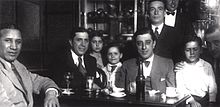| Revision as of 16:35, 18 December 2014 editBinksternet (talk | contribs)Autopatrolled, Extended confirmed users, File movers, Pending changes reviewers495,264 edits Reverted good faith edits by John B. Sullivan (talk): Rv... restore proper URL. (TW)← Previous edit | Revision as of 12:17, 29 April 2015 edit undoKasparBot (talk | contribs)1,549,811 edits authority control moved to wikidataNext edit → | ||
| Line 17: | Line 17: | ||
| * | * | ||
| {{Authority control |
{{Authority control}} | ||
| {{Persondata <!-- Metadata: see ]. --> | {{Persondata <!-- Metadata: see ]. --> | ||
Revision as of 12:17, 29 April 2015
| This article needs additional citations for verification. Please help improve this article by adding citations to reliable sources. Unsourced material may be challenged and removed. Find sources: "Pedro Maffia" – news · newspapers · books · scholar · JSTOR (August 2009) (Learn how and when to remove this message) |


Pedro Mario Maffia (August 28, 1899 – October 16, 1967) was an Argentine tango bandoneonist, bandleader, composer and teacher, as well as starring in several tango films.
Maffia had a hard upbringing, he was beaten with a chain by his father and lived in dire poverty. He eventually ran away from home to live in the town of Punta Alta in the Province of Buenos Aires, where he was discovered by Carlos Gardel and José Razzano.
Maffia is remembered as a pioneer of the bandoneon and a great stylist. He was one of the first to play the instrument a cappella. He had a relaxed playing style and an inventiveness for misplaced accents and nuances.
Maffia starred in a number of tango films including ¡Tango! (1933), Canillita (1936) and Fueye querido (1966). He also worked as a music teacher, and wrote an important method of teaching the bandoneon.
The bandoneonist Aníbal Troilo dedicated a song to him entitled A Pedro Maffia.